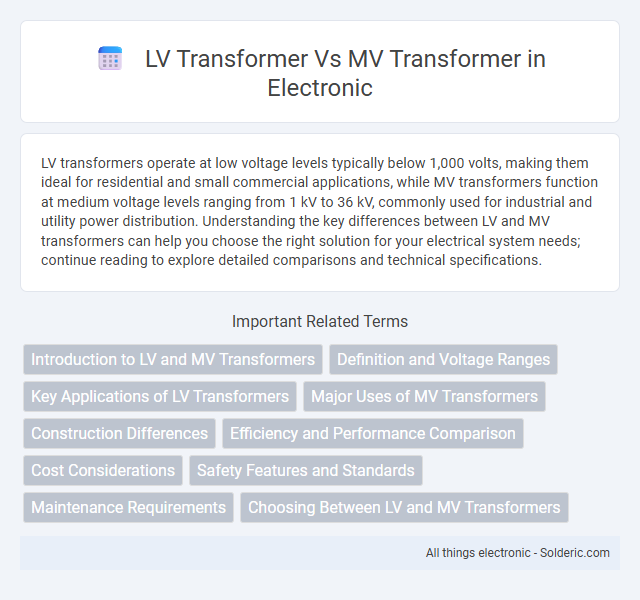LV transformers operate at low voltage levels typically below 1,000 volts, making them ideal for residential and small commercial applications, while MV transformers function at medium voltage levels ranging from 1 kV to 36 kV, commonly used for industrial and utility power distribution. Understanding the key differences between LV and MV transformers can help you choose the right solution for your electrical system needs; continue reading to explore detailed comparisons and technical specifications.
Comparison Table
| Feature | LV Transformer (Low Voltage) | MV Transformer (Medium Voltage) |
|---|---|---|
| Voltage Range | Up to 1 kV | 1 kV to 35 kV |
| Common Applications | Final distribution to residential and commercial loads | Power distribution from substations to local networks |
| Insulation Requirements | Lower insulation standards due to low voltage | Higher insulation standards to handle medium voltage |
| Size and Weight | Smaller and lighter | Larger and heavier |
| Cost | Lower cost | Higher cost due to complexity and materials |
| Cooling Methods | Natural cooling (air or oil) | Often oil-immersed or forced cooling |
| Primary Use | Step-down to usable voltage levels for end users | Step-down from primary distribution voltage to LV |
Introduction to LV and MV Transformers
LV transformers operate at low voltage levels typically below 1,000 volts, primarily used in residential and commercial electrical distribution to step down voltage for safe utilization. MV transformers function within medium voltage ranges, generally between 1kV and 35kV, facilitating the efficient transmission of electricity from substation grids to lower voltage distribution networks. Understanding the roles and voltage classifications of LV and MV transformers helps you optimize electrical infrastructure design and ensure appropriate equipment selection.
Definition and Voltage Ranges
LV transformers are electrical devices designed to operate at low voltage levels typically below 1,000 volts, commonly used for residential and small commercial applications. MV transformers function within medium voltage ranges, generally from 1 kV to 35 kV, serving industrial and utility distribution networks. Understanding your voltage requirements is crucial for selecting the appropriate transformer type to ensure efficient power distribution and equipment safety.
Key Applications of LV Transformers
LV transformers are primarily used in residential and commercial applications where voltage needs to be stepped down to safe, usable levels such as 120V or 240V for household appliances, lighting, and office equipment. These transformers are essential in power distribution systems for manufacturing facilities, ensuring machinery operates reliably and efficiently at low voltage. Your infrastructure benefits from LV transformers when integrating renewable energy sources like solar panels, where voltage regulation is crucial for stability and safety.
Major Uses of MV Transformers
MV transformers primarily serve in power distribution networks, stepping down high-voltage electricity from transmission lines to medium-voltage levels suitable for industrial and commercial applications. They are crucial in substations for managing voltage regulation and ensuring efficient power delivery across manufacturing plants, large buildings, and utility feeders. These transformers handle voltages typically between 1 kV and 36 kV, optimizing energy flow and minimizing losses in medium-voltage distribution systems.
Construction Differences
LV transformers feature thicker windings with fewer turns designed for low-voltage, high-current applications, while MV transformers use thinner insulation and more turns to handle medium-voltage levels efficiently. The core materials and insulation systems in MV transformers are engineered to withstand higher electrical stresses, ensuring safety and durability in distribution networks. Understanding these construction differences helps you select the appropriate transformer for your specific voltage requirements and operational conditions.
Efficiency and Performance Comparison
LV transformers typically demonstrate higher efficiency at lower load levels due to reduced core and copper losses, making them ideal for residential and light commercial applications. MV transformers are designed for industrial and utility-scale use, offering robust performance with greater insulation and cooling systems that maintain efficiency at higher voltages and load demands. Efficiency ratings for MV transformers often exceed 98%, while LV transformers generally range from 95% to 98%, reflecting their optimized design for specific voltage classes.
Cost Considerations
LV transformers typically have lower purchase and installation costs compared to MV transformers due to simpler design and reduced insulation requirements. Your choice impacts ongoing maintenance expenses, with MV transformers generally demanding higher investment in safety measures and monitoring systems. Evaluating total life-cycle costs, including energy losses and replacement frequency, is crucial for accurate cost consideration.
Safety Features and Standards
Low Voltage (LV) transformers incorporate enhanced safety features such as reinforced insulation, thermal protection, and earth fault detection to mitigate risks in residential and commercial applications. Medium Voltage (MV) transformers adhere to stringent industry standards like IEEE C57 and IEC 60076, ensuring robust protection against electrical faults and overloading in high-power distribution networks. Your choice between LV and MV transformers should prioritize compliance with relevant safety certifications and application-specific protective technologies.
Maintenance Requirements
LV transformers require less frequent maintenance due to lower voltage stress and simpler insulation systems compared to MV transformers. MV transformers demand more rigorous inspection routines, including regular testing of insulation resistance, oil quality, and tap changer functionality to prevent faults at higher operating voltages. Both types benefit from thermal monitoring and periodic cleaning, but MV transformers necessitate stricter adherence to maintenance schedules to ensure reliability and safety.
Choosing Between LV and MV Transformers
Choosing between LV (Low Voltage) and MV (Medium Voltage) transformers depends on application requirements such as voltage level, load capacity, and installation environment. LV transformers are typically utilized for final distribution in residential and commercial settings with voltages up to 1kV, while MV transformers serve as intermediaries in electrical grids, operating between 1kV and 35kV for efficient power transmission over longer distances. Evaluating factors like system voltage, load demand, and safety standards ensures optimal transformer selection for reliability and cost-effectiveness.
LV transformer vs MV transformer Infographic

 solderic.com
solderic.com